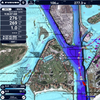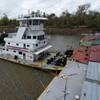Bering Sea Early Sea Ice Break-Up 2014
The National Snow & Ice Data Center informs that since reaching its annual maximum extent on March 21, Arctic sea ice extent has declined somewhat unevenly, but has consistently been well below its average 1981 to 2010 extent.
While the rate of Arctic-wide retreat was rapid through the first half of April, it has subsequently slowed down. However, ice breakup was quite early in the Bering Sea, presenting difficulties for gold dredging operations and seal hunters in the region. In the Antarctic, sea ice continued to reach record high extents.
April 2014 compared to previous years
Average ice extent for April 2014 was the fifth lowest for the month in the satellite record. Through 2014, the linear rate of decline for April ice extent is -2.4% per decade relative to the 1981 to 2010 average.
Overview of conditions
Arctic sea ice extent for April 2014 averaged 14.14 million square kilometers (5.46 million square miles). This is 610,000 square kilometers (236,000 square miles) below the 1981 to 2010 average extent, and 270,000 square kilometers (104,000 square miles) above the record April monthly low, which occurred in 2007.
While the rate of ice loss was rapid through the first half of April, it subsequently slowed down. The rate of ice loss averaged for the month was 30,300 square kilometers per day (11,700 square miles per day), which is slower than the average rate of 38,400 square kilometers per day (14,800 square miles per day) over the period 1981 to 2010. As of May 4, 2014, extent was below average in the Barents Sea, Sea of Okhotsk, and the Bering Sea, and slightly above average in Baffin Bay.
Early breakup in the Bering Sea
The anomalously low sea ice conditions in the Bering Sea are partially a result of low winter ice cover and an unusually early breakup of sea ice.
Citing 'The Fairbanks Daily News Miner' The National Snow & Ice Data Center reported that the unusually early breakup of ice in the Bering Sea forced several gold dredging operations to act quickly to get their equipment off the coastal sea ice, which is used as a platform to work shallow seabed gold deposits. Seal hunters were also impacted by the early breakup, in some cases abandoning their snowmobiles on the ice as it became unstable or impassable. The snowmobiles were later recovered by boat.
Source: The National Snow & Ice Data Center














